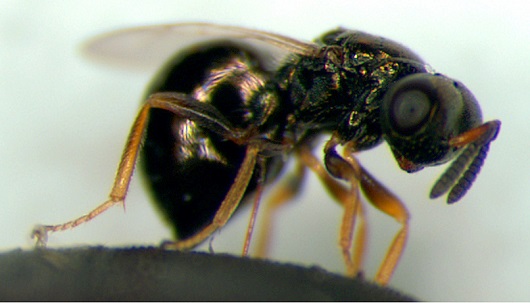Tiny jewels provide vital clue to avoiding extinction

The mating behaviour of tiny wasps could provide vital clues to how animals can protect themselves from extinction.
Researchers at the University of St Andrews have discovered that under laboratory conditions female wasps live longer by mating with multiple males.
The work of Rebecca Boulton and David Shuker of the School of Biology has been published in the journal Evolution under the title “The costs and benefits of multiple mating in a mostly monandrous wasp.”
The researchers conducted extensive studies into the behaviour of Nasonia vitripennis, commonly known as jewel wasps, collected from a national park site in the Netherlands.
“It is interesting that what they do in the lab and in the wild is different,” said Ms Boulton.
“In the wild the female rarely mates more than once. But conditions in the lab are completely different. There are more mating opportunities for females in the lab, and females tend to mate more than once.”
By mating with several males the female wasps increased their lifespan and the number of eggs they laid.
Ms Bolton said, “Females which mate with virgin males lay more eggs in total, and this benefit increases if they mate with two or three virgin males. If they mate with multiple males that had mated with another female previously, they actually lay fewer eggs than they would if they just mated once.
“In the lab there are more males around than in the wild, and so the likelihood a female will get the opportunity to mate with one or more virgin males is higher. If females in the lab are more likely to get benefits of mating multiply with virgin males then it might be one reason that females in the lab tend to mate more times than their wild counterparts.”
The work could have implications for animals facing extinction. “I think the most important thing is that we can change the mating system of these animals by bringing them in the lab,” said Ms Boulton.
“We can fundamentally alter their mating system and that can have repercussions for lots of things. One of the interesting things is that multiple matings might reduce the risk that a female will fail to reproduce at all and so may protect against extinction.”
ENDS
NOTES TO NEWS EDITORS
“The costs and benefits of multiple mating in a mostly monandrous wasp” by Rebecca Boulton and David Shuker is published in Evolution here: http://onlinelibrary.wiley.com/doi/10.1111/evo.12636/abstract
Images of Nasonia vitripennis the jewel wasp are available.
Issued by the University of St Andrews Communications Office, contactable on 01334 467310 or [email protected].
Category Research